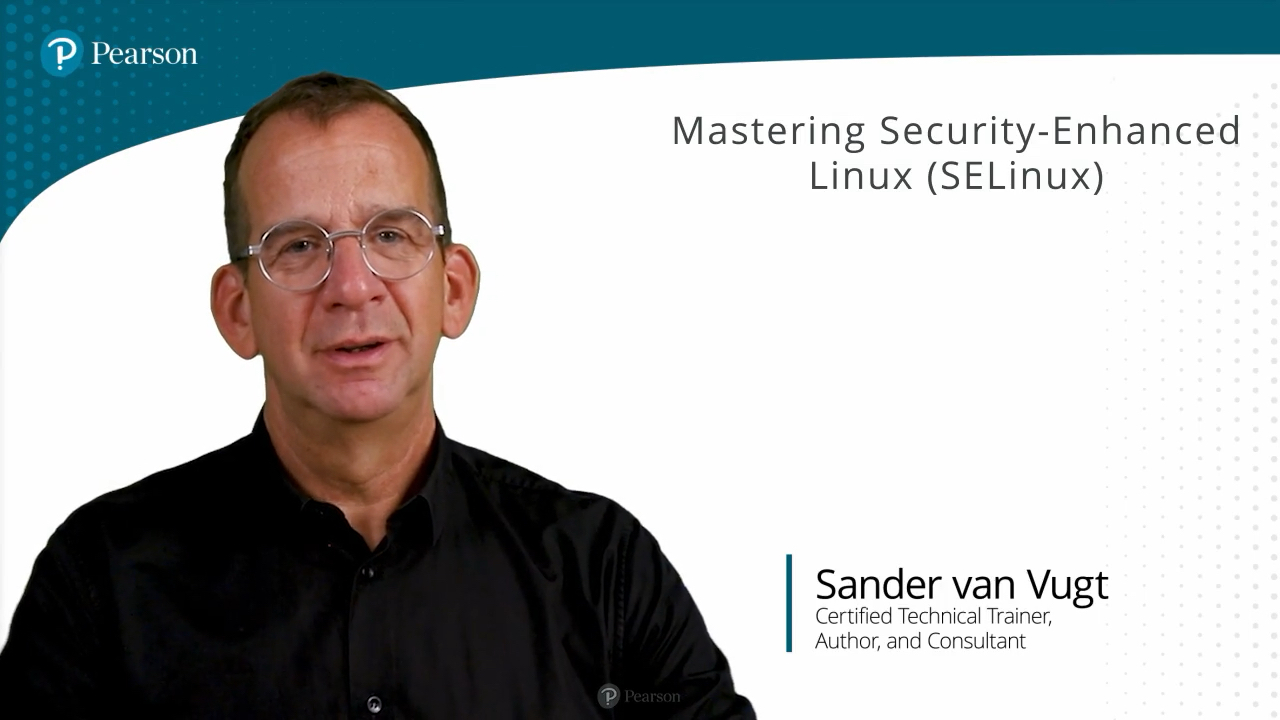Mastering Security-Enhanced Linux (SELinux) (Video Course)
- By Sander van Vugt
- Published Sep 29, 2023 by Addison-Wesley Professional.
Description
- Copyright 2024
- Edition: 1st
- Online Video
- ISBN-10: 0-13-828267-6
- ISBN-13: 978-0-13-828267-7
5+ Hours of Video Instruction
Everything you'll ever need to know about SELinux!
Overview:
Mastering Security-Enhanced Linux (SELinux) is your full training to understand and use SELinux. SELinux is a valuable addition to the standard Linux security options that makes your Linux distribution secure. The course starts with the basics of SELinux and goes deeper into more advanced topics like SELinux and Multi-Level Security or (MLS) and Multi-Category Security (MCS) and managing SELinux with Ansible. It also has in-depth coverage about SELinux in containerized environments. It has labs throughout so you can see SELinux in real time and practice as you learn.
Main features of the course are:
- Understand when SELinux and how it is needed
- Learn how to troubleshoot problems occurring because of SELinux
- Make your application work with SELinux
- Implement military grade security using SELinux MLS and MCS
This course is also a full resource for learners who want to thoroughly understand SELinux while preparing for any Red Hat Enterprise Linux related exam, as well as application developers and administrators who want to over the highest possible level of security by using SELinux.
Related Learning:
Sign up for live training classes by Sander van Vugt:
- Red Hat Certified Systems Administrator (RHCSA) RHEL 9 Crash course https://learning.oreilly.com/live-events/red-hat-certified-system-administrator-rhcsa-rhel-9-crash-course/0636920077845/0636920091658/
Topics included in this course:
- SELinux Fundamentals covers basic concepts like mandatory access control, how to enable SELinux, understanding context labels, managing context labels and how to use Booleans.
- Analyzing SELinux teaches how to analyze SELinux by covering troubleshooting and showing how to analyze Booleans and rules.
- Using Custom Applications with SELinux shows custom applications with SELinux and covers working with SELinux modules, and how to make any application work with SELinux.
- Military Grade Security with SELinux users and MLS offers three lessons about the best kind of protection and security that SELinux has to offer. It covers how SELinux can be used in military organization and covers topics of SELinux users, how to manage multi-level security and how to use multi-category security.
- Configuring SELinux for containers explains how to make a containerized environment absolutely secure by adding SELinux.
- Managing SELinux with Ansible covers how to secure containers with SELinux, and how to manage SELinux with Ansible.
Skill Level:
- Beginner
Learn How To:
- Understand SELinux
- Monitor SELinux behavior
- Manage SELinux Context Labels
- Manage SELinux Booleans
- Troubleshoot SELinux
- Create SELinux Policy Modules
- Secure Containers with SELinux
- Make Any Application work with SELinux
Course requirement:
- Install and configure a lab environment. This can be a Linux virtual machine that runs in virtualization software on the participants own computer, using software like VMware Workstation or Oracle VirtualBox, or on a dedicated computer. https://learning.oreilly.com/videos/red-hat-certified/9780134723990/
- Install a virtual or physical machine with a recent version of either Red Hat Enterprise Linux, CentOS Stream, Rocky Linux or Fedora.
Who Should Take This Course:
- DevOps Engineers
- DevSecOps Engineers
- Software Developers
- IT Administrators
- IT Architects
- Hybrid Cloud Administrators
- Students preparing for any Red Hat exam
About Pearson Video Training:
Pearson publishes expert-led video tutorials covering a wide selection of technology topics designed to teach you the skills you need to succeed. These professional and personal technology videos feature world-leading author instructors published by your trusted technology brands: Addison-Wesley, Cisco Press, Pearson IT Certification, Sams, and Que Topics include: IT Certification, Network Security, Cisco Technology, Programming, Web Development, Mobile Development, and more. Learn more about Pearson Video training at http://www.informit.com/video.
Video Lessons are available for download for offline viewing within the streaming format. Look for the green arrow in each lesson.
